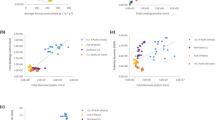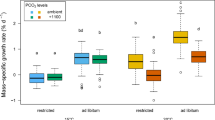Abstract
Climate change is an immediate and future threat to food security globally. The consequences for fisheries and agriculture production potential are well studied, yet the possible outcomes for aquaculture (that is, aquatic farming)—one of the fastest growing food sectors on the planet—remain a major gap in scientific understanding. With over one-third of aquaculture produced in marine waters and this proportion increasing, it is critical to anticipate new opportunities and challenges in marine production under climate change. Here, we model and map the effect of warming ocean conditions (Representative Concentration Pathway scenario 8.5) on marine aquaculture production potential over the next century, based on thermal tolerance and growth data of 180 cultured finfish and bivalve species. We find heterogeneous patterns of gains and losses, but an overall greater probability of declines worldwide. Accounting for multiple drivers of species growth, including shifts in temperature, chlorophyll and ocean acidification, reveals potentially greater declines in bivalve aquaculture compared with finfish production. This study addresses a missing component in food security research and sustainable development planning by identifying regions that will face potentially greater climate change challenges and resilience with regards to marine aquaculture in the coming decades. Understanding the scale and magnitude of future increases and reductions in aquaculture potential is critical for designing effective and efficient use and protection of the oceans, and ultimately for feeding the planet sustainably.
This is a preview of subscription content, access via your institution
Access options
Access Nature and 54 other Nature Portfolio journals
Get Nature+, our best-value online-access subscription
$29.99 / 30 days
cancel any time
Subscribe to this journal
Receive 12 digital issues and online access to articles
$119.00 per year
only $9.92 per issue
Buy this article
- Purchase on Springer Link
- Instant access to full article PDF
Prices may be subject to local taxes which are calculated during checkout




Similar content being viewed by others
Data availability
Computer code and data products reported in this paper are publicly accessible from the Knowledge Network for Biocomplexity data repository: https://doi.org/10.5063/F1SX6BDP.
References
Waite, R. et al. Improving Productivity and Environmental Performance of Aquaculture (World Resources Institute, 2014).
The State of World Fisheries and Aquaculture (SOFIA) (FAO, 2016).
Hambrey, J. The 2030 Agenda and the Sustainable Development Goals: The Challenge for Aquaculture Development and Management FAO Fisheries and Aquaculture Circular 1141 (Food and Agriculture Organization of the United Nations, 2017).
Gentry, R. R. et al. Mapping the global potential for marine aquaculture. Nat. Ecol. Evol. 1, 1317–1324 (2017).
Barange, M., King, J., Valdés, L. & Turra, A. The evolving and increasing need for climate change research on the oceans. ICES J. Mar. Sci. 73, 1267–1271 (2016).
Cheung, W. W. et al. Large-scale redistribution of maximum fisheries catch potential in the global ocean under climate change. Glob. Change Biol. 16, 24–35 (2010).
Barange, M. et al. Impacts of climate change on marine ecosystem production in societies dependent on fisheries. Nat. Clim. Change 4, 211–216 (2014).
Blanchard, J. L. et al. Potential consequences of climate change for primary production and fish production in large marine ecosystems. Phil. Trans. R. Soc. B 367, 2979–2989 (2012).
Blanchard, J. L. et al. Linked sustainability challenges and trade-offs among fisheries, aquaculture and agriculture. Nat. Ecol. Evol. 1, 1240–1249 (2017).
Feely, R., Doney, S. & Cooley, S. Ocean acidification: present conditions and future changes in a high-CO2 world. Oceanography 22, 36–47 (2009).
Klinger, D. H., Levin, S. A. & Watson, J. R. The growth of finfish in global open-ocean aquaculture under climate change. Proc. R. Soc. B 284, 20170834 (2017).
Reid, G. K., Filgueira, R. & Garber, A. Revisiting temperature effects on aquaculture in light of pending climate change. In Aquaculture Canada Proceedings of Contributed Papers Vol. 2015-1 (Bulletin of the Aquaculture Association of Canada, 2015).
Froehlich, H. E., Gentry, R. R. & Halpern, B. S. Synthesis and comparative analysis of physiological tolerance and life-history growth traits of marine aquaculture species. Aquaculture 460, 75–82 (2016).
Kumar, G., Engle, C. & Tucker, C. Factors driving aquaculture technology adoption. J. World Aquac. Soc. 49, 447–476 (2018).
Cisneros-Montemayor, A. M., Pauly, D., Weatherdon, L. V. & Ota, Y. A global estimate of seafood consumption by coastal indigenous peoples. PLoS ONE 11, e0166681 (2016).
Cooley, S. R., Lucey, N., Kite-Powell, H. & Doney, S. C. Nutrition and income from molluscs today imply vulnerability to ocean acidification tomorrow. Fish Fish. 13, 182–215 (2012).
Belton, B., Bush, S. R. & Little, D. C. Not just for the wealthy: rethinking farmed fish consumption in the Global South. Glob. Food Secur. 16, 85–92 (2018).
Bell, J. D. et al. Effects of climate change on oceanic fisheries in the tropical Pacific: implications for economic development and food security. Clim. Change 119, 199–212 (2012).
Froehlich, H. E., Gentry, R. R. & Halpern, B. S. Conservation aquaculture: shifting the narrative and paradigm of aquaculture’s role in resource management. Biol. Conserv. 215, 162–168 (2017).
Marshall, K. N. et al. Risks of ocean acidification in the California Current food web and fisheries: ecosystem model projections. Glob. Change Biol. 23, 1525–1539 (2017).
Silbiger, N. J. & Sorte, C. J. B. Biophysical feedbacks mediate carbonate chemistry in coastal ecosystems across spatiotemporal gradients. Sci. Rep. 8, 796 (2018).
Laufkötter, C. et al. Drivers and uncertainties of future global marine primary production in marine ecosystem models. Biogeosciences 12, 6955–6984 (2015).
Gobler, C. J. et al. Ocean warming since 1982 has expanded the niche of toxic algal blooms in the North Atlantic and North Pacific oceans. Proc. Natl Acad. Sci. USA 114, 4975–4980 (2017).
Lafferty, K. D. The ecology of climate change and infectious diseases. Ecology 90, 888–900 (2009).
Burge, C. A. et al. Climate change influences on marine infectious diseases: implications for management and society. Annu. Rev. Mar. Sci. 6, 249–277 (2014).
Leung, T. L. & Bates, A. E. More rapid and severe disease outbreaks for aquaculture at the tropics: implications for food security. J. Appl. Ecol. 50, 215–222 (2013).
Breitburg, D. et al. Declining oxygen in the global ocean and coastal waters. Science 359, eaam7240 (2018).
Weatherdon, L. V., Magnan, A. K., Rogers, A. D., Sumaila, U. R. & Cheung, W. W. L. Observed and projected impacts of climate change on marine fisheries, aquaculture, coastal tourism, and human health: an update. Front. Mar. Sci. 3, 48 (2016).
Handisyde, N. T., Ross, L. G., Badjeck, M. C. & Allison, E. H. The Effects of Climate Change on World Aquaculture: A Global Perspective (Department for International Development, 2006).
Filgueira, R., Guyondet, T., Comeau, L. A. & Tremblay, R. Bivalve aquaculture–environment interactions in the context of climate change. Glob. Change Biol. 22, 3901–3913 (2016).
Christiansen, J. S., Mecklenburg, C. W. & Karamushko, O. V. Arctic marine fishes and their fisheries in light of global change. Glob. Change Biol. 20, 352–359 (2014).
Froehlich, H. E., Smith, A., Gentry, R. R. & Halpern, B. S. Offshore aquaculture: I know it when I see it. Front. Mar. Sci. 4, 154 (2017).
R Core Development Team R: A Language and Environment for Statistical Computing (R Foundation for Statistical Computing, 2017).
Taylor, K. E., Stouffer, R. J. & Meehl, G. A. An overview of CMIP5 and the experiment design. Bull. Am. Meteorol. Soc. 93, 485–498 (2011).
Tittensor, D. P. et al. A protocol for the intercomparison of marine fishery and ecosystem models: Fish-MIP v1.0. Geosci. Model Dev. 11, 1421–1442 (2018).
Brown, P. T. & Caldeira, K.Greater future global warming inferred from Earth’s recent energy budget. Nature 552, 45–50 (2017).
Grieve, B. D., Hare, J. A. & Saba, V. S. Projecting the effects of climate change on Calanus finmarchicus distribution within the U.S. Northeast Continental Shelf. Sci. Rep. 7, 6264 (2017).
Blanchette, C. A., Helmuth, B. & Gaines, S. D. Spatial patterns of growth in the mussel, Mytilus californianus, across a major oceanographic and biogeographic boundary at Point Conception, California, USA. J. Exp. Mar. Biol. Ecol. 340, 126–148 (2007).
Page, H. M. & Hubbard, D. M. Temporal and spatial patterns of growth in mussels Mytilus edulis on an offshore platform: relationships to water temperature and food availability. J. Exp. Mar. Biol. Ecol. 111, 159–179 (1987).
Bopp, L. et al. Multiple stressors of ocean ecosystems in the 21st century: projections with CMIP5 models. Biogeosciences 10, 6225–6245 (2013).
Clements, J. C. & Chopin, T. Ocean acidification and marine aquaculture in North America: potential impacts and mitigation strategies. Rev. Aquacult. 9, 326–341 (2016).
Thomsen, J. et al. Naturally acidified habitat selects for ocean acidification-tolerant mussels. Sci. Adv. 3, e1602411 (2017).
Mangan, S., Urbina, M. A., Findlay, H. S., Wilson, R. W. & Lewis, C. Fluctuating seawater pH/pCO2 regimes are more energetically expensive than static pH/pCO2 levels in the mussel Mytilus edulis. Proc. R. Soc. B 284, 20171642 (2017).
Fabry, V. J., Seibel, B. A., Feely, R. A. & Orr, J. C. Impacts of ocean acidification on marine fauna and ecosystem processes. ICES J. Mar. Sci. 65, 414–432 (2008).
Feely, R. A. et al. The combined effects of ocean acidification, mixing, and respiration on pH and carbonate saturation in an urbanized estuary. Estuar. Coast. Shelf Sci. 88, 442–449 (2010).
Gaylord, B. et al. Ocean acidification through the lens of ecological theory. Ecology 96, 3–15 (2015).
Acknowledgements
This research was funded by the Zegar Family Foundation through the ‘Anticipating Climate Change Impacts on Ocean Aquaculture’ project.
Author information
Authors and Affiliations
Contributions
H.E.F., R.R.G. and B.S.H. conceived the initial study. H.E.F. and R.R.G. developed the research and methodology, with critical input and insight from B.S.H. H.E.F. and R.R.G. collected and processed the data. H.E.F. conducted the analyses. All authors interpreted the results and implications. H.E.F. produced the figures. H.E.F. drafted the manuscript with significant input and revisions from all authors.
Corresponding author
Ethics declarations
Competing interests
The authors declare no competing interests.
Additional information
Publisher’s note: Springer Nature remains neutral with regard to jurisdictional claims in published maps and institutional affiliations.
Supplementary information
Supplementary Information
Supplementary Tables 1–2; Supplementary Figures 1–16
Supplementary Data 1
Probability of decline of suitable area in respective Exclusive Economic Zones (EEZs) of countries/territories for finfish and bivalves for each time step. Time steps correspond to (a) 2010–2030 relative to historic (1985–2005; Δt1), (b) 2030–2050 relative to 2010–2030 (Δt2), (c) 2050–2070 relative to 2030–2050 (Δt3), and (d) 2070–2090 relative to 2050–2070 (Δt4). A ‘na’ in the bivalve column indicates non-suitable condition based on our assumed global modelling constraints (temperature and chlorophyll).
Rights and permissions
About this article
Cite this article
Froehlich, H.E., Gentry, R.R. & Halpern, B.S. Global change in marine aquaculture production potential under climate change. Nat Ecol Evol 2, 1745–1750 (2018). https://doi.org/10.1038/s41559-018-0669-1
Received:
Accepted:
Published:
Issue Date:
DOI: https://doi.org/10.1038/s41559-018-0669-1
This article is cited by
-
Spatiotemporal variation of China’s mariculture potential under climate change
Reviews in Fish Biology and Fisheries (2024)
-
Mediterranean Sea heatwaves jeopardize greater amberjack’s (Seriola dumerili) aquaculture productivity through impacts on the fish microbiota
ISME Communications (2023)
-
The global ecological niche of lumpfish (Cyclopterus lumpus) and predicted range shifts under climate change
Hydrobiologia (2023)
-
Vulnerability of blue foods to human-induced environmental change
Nature Sustainability (2023)



